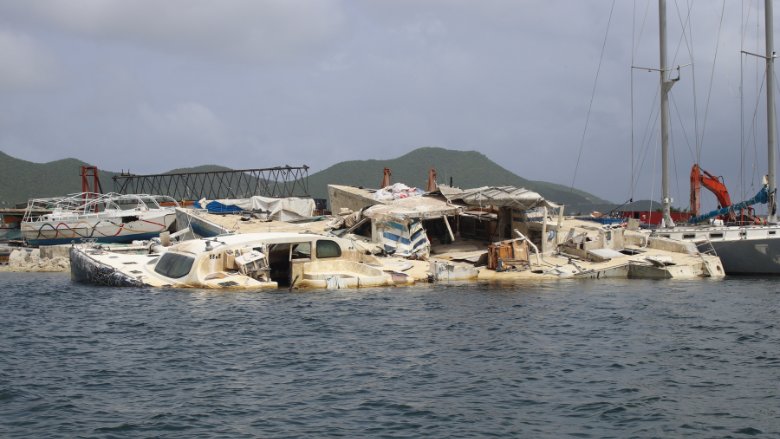The Simpson Bay Lagoon is usually a tranquil harbor for sailing vessels. But when Hurricane Irma slammed into Sint Maarten with winds up to 180 miles per hour, not even the most securely moored ship could withstand the force. The result was 139 shipwrecks that needed to be cleared as soon as possible. After essential parts, such as engines, had been removed, clearing the wreckage and cleaning the island was the priority, since debris like fiberglass is an environmental hazard. And that’s where Paul Ellinger came in.
“Right after Hurricane Irma in September of 2017, I was approached by the Marine Trades Association, mariners, and other stakeholders within the maritime sector of Sint Maarten. They said, ‘We have a problem. We have so many crushed, sunken, and wrecked boats inside the base of the marina. How can you assist?’” says Paul. “The first thing I did, together with some colleagues, and with assistance from the Nature Foundation of Sint Maarten, was a rapid assessment of the vessels. At that point in time, I had 450–460 boats that were damaged and crashed within the Dutch waters of Sint Maarten.”
Paul is a knowledgeable ship inspector who works for the Government of Sint Maarten’s Shipping and Maritime Inspectorate. It is one department with two sections: aviation, aircraft, and registration on one end and shipping and maritime on the other. Paul says, “I have wide knowledge of the Sint Maarten maritime industry. I know the ecological aspects of the coastal waters both inland and on Sint Maarten. I also have quite a bit of knowledge of the island itself.”
While insurance companies cleared the initial clutter, the government was tasked with addressing what remained. Because funding was a challenge, the team sought ways to finance the cleanup and the then newly formed Sint Maarten Trust Fund came to the rescue.
The Emergency Debris Management Project (EDMP), managed by Sint Maarten's National Recovery Program Bureau (NRPB), was the mechanism through which the lagoon would again become functional. The Simpson Bay Lagoon and Mullet Pond shipwreck salvaging and cleanup cost US$15 million, just over half of the
US$25 million initially allocated to the EDMP. Paul and the team were able to clear the 139 shipwrecks, disposing of almost 4,000 metric tons of waste in an environmentally friendly manner.
Paul’s team, along with the NRPB, Nature Foundation, and other partners, collected data, took photos, marked the GPS coordinates of each wreckage, and made a map.
Successful Salvage
The EDMP was the second Sint Maarten Trust Fund project to come onstream in December 2018. It was created to effectively and efficiently collect and process debris across the island in the aftermath of Hurricane Irma.
In February 2023, the project received a further US$60 million, bringing the total to US$85 million to reach its targets. Along with clearing the shipwrecks, the project is also charged with reconditioning and improving the solid waste disposal site and Irma Debris Deposal Site on Pond Island. This was made possible by the additional financing.
The team successfully navigated concerns from landowners and had a near perfect record of satisfying the conditions required by the World Bank and the government to complete the shipwreck removal project, including permitting, land issues, and dismantling the vessels. The shipwrecks had also become home to a variety of sea life, including fish and lobster, and with the help of the Nature Foundation, coral and other creatures were safely removed and rehomed, saving species that are indigenous to Sint Maarten.
Looking Forward
“We can gladly say that we have an exceptionally clean lagoon,” says Paul. “We can start to receive tourists; people can have a clean lagoon again.”
As part of his work, Paul has come up with new strategies for preventing this type of catastrophe. He is in consultation with stakeholders to introduce new rules and regulations for ships and vessels that enter the lagoon. “If you come into the lagoon, you are going to have insurance with a clause that has what we call wreck removal.”
Paul is also trying to reinstate a harbor master who manages the flow of maritime traffic in and out of the lagoon or other Sint Maarten waters. “With the right legislation, for example, my department can have that problem resolved so that we don’t have to spend that kind of money to do such a project.”
“I am happy to say I feel honored to be a participating individual in this component of the project. I think it’s one of the most successful projects that the Trust Fund has done in Sint Maarten so far." — Paul G. Ellinger, Ship Inspector, Shipping and Maritime Inspectorate of Sint Maarten

